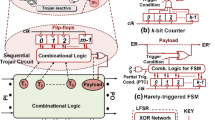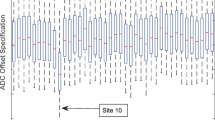Abstract
IDDQ or steady state current testing has been extensively used in the industry as a mainstream defect detection and reliability screen. The background leakage current has increased significantly with the advent of ultra deep submicron technologies. This increased background leakage noise makes it difficult to differentiate defect-free devices from those with defects that draw significantly small amount of currents. Therefore it is impossible to use single threshold IDDQ testing for today’s technologies. Several techniques that improve the resolution of IDDQ testing have been proposed to replace the single threshold detection scheme. However, even these techniques are suffering from loss of resolution that is required for detection of subtle defects in the presence of leakage currents in excess of a few mA. All these techniques use a single IDDQ measurement for detection and thus the scalability of these techniques is limited. Quiescent Signal Analysis (QSA) is a novel IDDQ defect detection and diagnosis technique that uses IDDQ measurements at multiple chip supply pads. Implicit in our methodology is a leakage calibration technique that scales the total leakage current over multiple simultaneous measurements. This helps in decreasing the background leakage component in individual measurements and thus increases the resolution of this technique to subtle defects. Defect detection is accomplished by applying linear regression analysis to the multiple supply port measurements and using outlier analysis to identify defective devices. The effectiveness of this technique is demonstrated in this paper using simulation experiments on portion of a production power grid. Predicted chip size and leakage values from the International Technology Roadmap for semiconductors (ITRS) are used in these experiments. One of the other major concerns expressed in ITRS is that of significant increase in intra-die process variations. The performance of the proposed technique in presence of such variations is evaluated using three different intra-die process variation distribution models.
Similar content being viewed by others
References
D. Acharyya and J. Plusquellic, “Impedance Profile of a Commercial Power Grid and Test System,” in Proceedings International Test Conference, 2003, pp. 709–718.
W.R. Daasch, J. McNames, D. Bockelman, and K. Cota, “Variance Reduction Using Wafer Patterns in IDDQ Data,” in Proceeding International Test Conference, 2000, pp. 189–198.
A.E. Gattiker and W. Maly, “Current Signatures,” in Proceeding IEEE VLSI Test Symposium, 1996, pp.112–117.
A. Germida, Zheng Yan, J.F. Plusquellic, and F.l. Muradali, “Defect Detection Using Power Supply Transient Signal Analysis,” in Proceeding International Test Conference, 1999, pp. 67–76.
S. Jandhyala, H. Balachandran, and A.P. Jayasumana, “Clustering Based Techniques for IDDQ Testing,” in Proceeding International Test Conference, 1999, pp. 730–737.
P. Maxwell, P.O’ Neill, R. Aitken, R. Dudley, N. Jaarsma, M. Quach, and D. Wiseman, “Current Ratios: A self-Scaling Technique for Production IDDQ Testing,” in Proceedings International Test Conference, 1999, pp. 738–746.
C. Patel and J. Plusquellic, “A Process and Technology-Tolerant IDDQ Method for IC Diagnosis,” in Proceedings VLSI Test Symposium, 2001, pp. 145–150.
C. Patel, E. Staroswiecki, D. Acharyya, S. Pawar, and J. Plusquellic, “A Current Ratio Model for Defect Diagnosis Using Quiescent Signal Analysis,” in Proceedings IEEE International Workshop on Defect Based Testing, 2002.
C. Patel, E. Staroswiecki, S. Pawar, D. Acharyya, and J. Plusquellic, “Defect Diagnosis Using a Current Ratio Based Quiescent Signal Analysis Model for Commercial Power Grids,” Journal of Electronic Testing, Theory and Applications, vol. 19, no. 6, pp. 611–623, Dec. 2003.
J. Plusquellic, “IC Diagnosis Using Multiple Supply Pad IDDQs,” IEEE Design and Test, Special Issue on Diagnosis, Oct. 2001, pp. 50–61.
A. Singh, “A Comprehensive Wafer Oriented Test Evaluation (WOTE) Scheme for the IDDQ Testing of Deep Sub-Micron Technologies,” in Proceedings IEEE International Workshop on IDDQ Testing, 1997.
C. Thibeault, “On the Comparison of Delta IDDQ and IDDQ test,” In proceedings IEEE VLSI Test Symposium, 1999, pp. 143–150.
P.N. Variyam, “Increasing the IDDQ Test Resolution Using Current Prediction,” in Proceeding International Test Conference, 2000, pp. 217–224.
T.W. Williams, R.H. Dennard, R. Kapur, M.R. Mercer, and W. Maly, “IDDQ test: Sensitivity Analysis of Scaling,” in Proceedings International Test Conference 1996, pp. 786–792.
Author information
Authors and Affiliations
Corresponding author
Rights and permissions
About this article
Cite this article
Patel, C., Singh, A. & Plusquellic, J. Defect Detection Using Quiescent Signal Analysis. J Electron Test 21, 463–483 (2005). https://doi.org/10.1007/s10836-005-2783-7
Received:
Revised:
Issue Date:
DOI: https://doi.org/10.1007/s10836-005-2783-7




